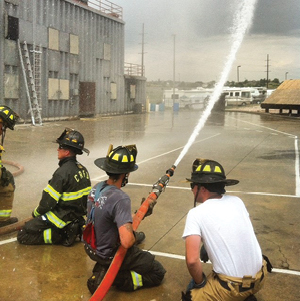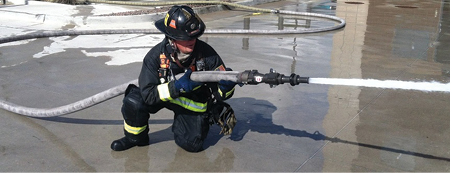Engine company operations are based around the mission of getting water on the fire. To accomplish this goal, firefighters use hoselines and nozzles as a delivery system to transport water from a pump discharge to the fire area and apply it to the fire. You can execute every aspect of the fire attack operation perfectly, but the operation can still fail if you do not manage hoselines and nozzles correctly. Nozzle management is a basic skill that all firefighters should master. It consists of multiple aspects such as nozzle and nozzle hand positioning and nozzle movement.
Nozzle and Hand Positioning
Nozzle positioning and hoseline management are critical to the fire attack operation. If incorrect nozzle positioning occurs, the nozzle team may struggle to operate the nozzle in a manner that directs the fire stream at the fire, making it more difficult to move the nozzle in any direction. Similarly, improper hose management can make maneuvering a hoseline more difficult when navigating the nozzle around corners, turns, and other friction points. Many times, incorrect nozzle positioning is the result of the nozzle firefighter’s using the nozzle’s pistol grip to control the nozzle. When the pistol grip of the nozzle is used during fire attack, the nozzle typically ends up positioned in the nozzle firefighter’s armpit. The nozzle is ineffective when it is in this position unless the fire is directly in front of the nozzle firefighter and is of low enough intensity that it can be extinguished with little or no nozzle movement. Additionally, when you hold the nozzle in this position, the hose has a tendency to kink directly behind the nozzle.
The correct position for the nozzle is about an arm’s length in front of the nozzle firefighter. Position the nozzle in front of the nozzle firefighter, but the control bail of the nozzle should never extend beyond the reach of the nozzle firefighter. When correctly positioned in front of the nozzle firefighter, the nozzle firefighter should be able to use the nozzle control bail at any time. When a fog nozzle is used, the nozzle firefighter must also always be able to reach and control the adjustable fog tip.

(1) The positioning of the firefighter’s rear hand allows for the hoseline to be “pinned” up against the firefighter’s hip to assist in resisting the nozzle reaction forces. (Photos courtesy of Brian Brush.)
The positioning of the nozzle firefighter’s hands is very important. Proper hand positioning will not only allow for effective use of the nozzle but it will also limit the amount of strength required by the nozzle firefighter to combat nozzle reaction. A backup firefighter who is properly positioned on the hoseline behind the nozzle firefighter is a vital member of the nozzle team. A skilled backup firefighter can absorb most of the nozzle reaction and literally “lighten up” on the hoseline when it is advanced. Although a backup firefighter allows the nozzle firefighter to focus on directing the nozzle’s stream, he cannot absorb all the nozzle’s reaction. Therefore, it is critical that the nozzle firefighter hold the hoseline properly to operate the nozzle effectively and resist its reaction forces.
In the three most common hand positions for nozzle firefighters, the forward hand position remains the same: with an underhand grip close to the coupling that connects the nozzle to the hoseline. In this position, the nozzle firefighter’s forward hand can allow for additional nozzle movement as opposed to if the hand were positioned on the nozzle itself. While using an underhand grip, the nozzle firefighter can position the elbow of his forward arm against his body to help resist the nozzle’s reaction. By positioning his elbow against his body, the nozzle firefighter can conserve energy and focus on operating the nozzle.
The main differences in the three hand positioning options are the position of the nozzle firefighter’s rear hand as well as the position of the hoseline against his body. For the first option, the nozzle firefighter should position his rear hand in either an underhand or side grip next to his hip. By positioning his hand in this way, the nozzle firefighter can push the hoseline against his hip to help absorb the nozzle reaction, essentially “pinning” the hoseline to his hip.
For the second option, the nozzle firefighter positions his rear hand in an underhand grip just in front of his chest with the hoseline in his armpit. When using this hand position, he can “pin” the hoseline in his armpit with his arm and the side of the chest to assist in resisting the nozzle reaction forces.
For the third hand-positioning option, the nozzle firefighter positions his leg that is on the opposite side of the hoseline and raises his other knee (the one next to the hoseline) and positions his rear hand in an underhand grip. The difference between the second and third options is that the third option requires the nozzle firefighter to position the elbow of his rear arm against his raised leg; this provides him with additional assistance in resisting the nozzle reaction forces.

(2) By positioning his elbow against his raised leg, the firefighter increases his ability to resist the nozzle reaction forces.
Nozzle Movement
Proper nozzle management also includes using correct nozzle movement, of which there are two types: advancing and fire attack. The two primary times you will need to use the nozzle while advancing a hoseline are to cool the floor and any burning or smoldering objects on the floor and to clear a pathway of hazards for the nozzle team as it advances.
The two most common advancing nozzle movements are “sweeping the floor” and “the bounce.” They are used in conjunction with each other—one after the other—as the nozzle team advances. When sweeping the floor, the nozzle stream is directed at the floor in front of the advancing nozzle team and operated in a side-to-side motion to clear a path for the nozzle team. “The bounce,” on the other hand, does not use the side-to-side motion of “sweeping the floor”; instead, the bounce requires the nozzle firefighter to direct the nozzle stream at the floor ahead of the advancing nozzle team in a quick up-and-down motion (as if the nozzle is “bouncing”). The nozzle team should listen to the stream as it strikes the floor; a change in the stream’s sound could indicate that there is a stairway or a hole in the floor ahead of them.
It is important that the nozzle firefighter ensures that he directs the nozzle stream at the floor directly in front of his line of sight when performing either of these techniques. It is easy to accidentally direct the stream at the floor several feet around him, but this does not clear a direct path in front of him. Instead, he should have the nozzle stream impact the ground directly in front of his position.
When the hose reaches the fire area, proper fire attack nozzle movement is required. The best way to describe proper fire attack nozzle movement is “aggressive,” which is the most effective type of fire attack nozzle movement regardless of the movement pattern being used. Simply directing the fire stream in the area of the fire and leaving the stream in that position will not effectively extinguish the fire. Lazy nozzle movement that moves the fire stream across the area slowly is much less effective than aggressive nozzle movement.
The two most common nozzle movement patterns are the “O” and “Z” patterns, which involve the nozzle firefighter operating the nozzle in a coordinated pattern of the letters “O” or “Z.” Another commonly used nozzle movement is the “inverted U.” Here, the nozzle stream is directed at the point where the ceiling and wall meet. Then, the stream is directed across the ceiling, down the opposite wall, back up the wall and across the ceiling, down the first, and then back up the celling. Regardless of which nozzle movement pattern you use, perform these nozzle movements aggressively and with rapid movement.
Nozzle movement must begin at the ceiling level because that area contains the highest temperatures and must be cooled. Also, some of the water deflected off the ceiling will fail to cool the fuels that are producing the layer of fire gases. Once the fire stream is in operation and has been directed at the ceiling level, the nozzle firefighter can now operate the fire stream on the rest of the fire area.
There is more to the nozzle firefighter position than opening and closing the nozzle control bail. An effective nozzle firefighter must know how to properly position the nozzle as well as his hands on the hoseline. The nozzle firefighter must also operate the nozzle effectively, best described as aggressive nozzle movement. Combining these aspects of nozzle management will allow the nozzle operation to be effective.
ANTHONY ROWETT JR. is a captain with the Mobile (AL) Fire Rescue Department. He previously was a volunteer firefighter with the Ogdensburg (NJ) Fire Department. He has an associate degree in fire science technology from County College of Morris (NJ), a bachelor’s degree in fire science, and a master’s degree in emergency services management from Columbia Southern University. He has been published in Fire Engineering and FireRescue magazines.

